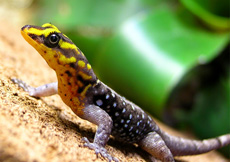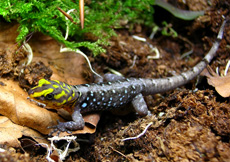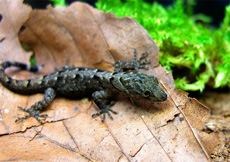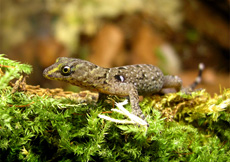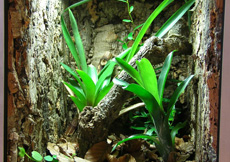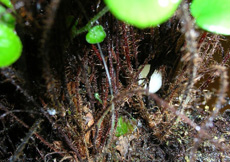Gonatodes caudiscutatus
(GÜNTHER, 1855)
Distribution:
Colombia, Ecuador (West), Peru, Galapagos Islands (introduced)
Description:
Gonatodes caudiscutatus is one of the smaller members of the genus Gonatodes. Adult males of this species very rarely reach 9 centimeters in length, they more range around 8 centimeters in total length. As with all other members of the genus Gonatodes, sexual dimorphism is strong. The males base color is black. They have a yellow mottled head mask, which is separated from the rest of the body pattern, by a narrow yellow collar at the base of the neck. Their back has a weak grayish line, the edges of this line are decorated by blue dots, with a black outline. These dots merge in to bands over the tail and are characteristic for this species. Their throat is bright yellow, while the rest of their ventral color is black. Females of Gonatodes caudiscutatus, are much more simple in color. Their head and body is gray. Over their back is a bright line, as well as a diamond pattern, which ends at the base of the tail. Their tail, is similar to the males and is also marked with bright bands. At their sides are also blue dots, however unlike the males, they are edged with gray. The females' ventral color, is beige.
Gonatodes caudiscutatus juveniles resemble the mother when hatching. At about 8 months, young males will easily be distinguishable, from females. Gonatodes caudiscutatus reaches sexual maturity at one year.
Habitat:
Gonatodes caudiscutatus is found in semi-arid to humid regions at the roots of trees in a shaded area. In Ecuador, this species could be observed on hotel walls, before sunset (HORN, oral Communication). Overall, due to their secretive habits, little is known about the natural lifestyle of Gonatodes caudiscutatus.
Husbandry and Breeding:
For a pair, a terrarium measuring 30x40x30 centimeters is sufficient. To provide the pair additional climbing surfaces, the rear and side walls should be covered with natural cork or similar. The substrate should a mixture of soil and 1/4 sand. Pieces of cork should be arranged around the ground of the terrarium to allow for hiding or egg laying. Natural vegetation such as, bromeliads, orchids and small trailing plants may be used. A natural planting of the terrarium helps provide a better microclimate and makes for a more visually appealing centerpiece. Additional pieces of cork and upright branches further serve as climbing possibilities. A small water bowl and a bowl of eggshells (from older hatchlings) or cuttlefish bone (crushed - not ground) are a must in completing the setup.
Lighting via a T5 or T8 tube, should be provided. Recent observations show Gonatodes regularly enjoy basking sites. Pregnant females, especially, seem particular to elevated temperatures. Halogen puck lights are a good solution for providing these sites. However, a switch to shut off these lamps (if used) should always be included, with such small terrariums, to prevent overheating. Daily temperatures should be kept between 24-28°C (75.2-82.4°F) and drop 2-4 degrees nightly. Under the basking sites, temperatures of 38°C (100.4°F) may safely be reached. The required humidity of 70-80% is achieved, by daily misting of the enclosure.
Gonatodes caudiscutatus feeds on small insects, such as small crickets, tropical woodlice, firebrats, Drosophila, springtails, houseflies and other insects in a suitable size. All food should be dusted with the appropriate supplements. It is optimal to seed the substrate of the terrarium with tropical woodlice and springtails before including the pair, so they can always capture a small snack if need be.
Gonatodes caudiscutatus may be observed throughout the terrarium in the morning hours, as well as later in the afternoon until the beginning of the night.
Three weeks after a successful mating period, the female lays a single egg in a secretive location, usually between trailing plants or behind pieces of cork. Sometimes, it may happen that the female buries her eggs beneath the substrate. With good care, the female will lay a single egg, at a rate of about every 3 weeks. It is important due to this reason, to supply the female with adequate calcium, that is why it is recommended above, to include a small bowl of eggshells (from older hatchlings) or cuttlefish bone (crushed - not ground). It is better to remove the eggs from the terrarium and transferred to an incubator. Following an incubation temperature pattern of 27-28°C (80.6-82.4°F) the young emerge between 90-110 days. The tiny 3.5 centimeter hatchlings may be raised communally or individually in small converted household containers. Illumination of these containers may be provided through a small fluorescent tube, which also provides the necessary heat. The young feed mainly on springtails and pinhead crickets in the firsts weeks. Later on Drosophila, firebrats and houseflies may be included in to their diet. After about 4-5 months, young males begin to color up and should be separated from one another, as well as from the opposite sex. After a period of one year, they are ready for breeding.
In autumn the terrarium should be maintained at 24°C (75.2°F) daily. In the winter months a nightly reduction to 18°C (64.4°F), should be provided, as this allows the female a proper cooling period, so she can recover from the stress of the breeding season. It is also possible to allow for a recovery period, by separating the pair for 3-4 months. With good care, Gonatodes caudiscutatus can live for 8 years or more in captivity.
All around, Gonatodes caudiscutatus is a very nice and interesting terrarium inhabitant, which can easily be observed during the described periods above.
